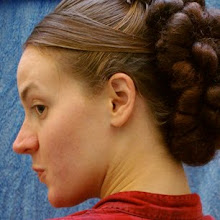
While I have been busy transitioning to the next phase in life and morning the loss of my nice digital SLR camera, I have sourly neglected this blog. I hope to be able to return to it when I can, without excuses--just recipes. Here we go.
Squash is readily available and delicious here in Morocco. You can easily get it all year 'round but it is, of course, in season right now. Seeing those big orange hunks of flesh exposed as the seller cuts off a hunk of your choosing is just too tempting to pass up. The red squash we know and love here is not exactly "pumpkin" but it tastes and looks like a close cousin, or maybe even a brother of our American sugar-pumpkin. You can treat the two as equals.
To make pumpkin/squash puree, cut the pumpkin into hunks and brush with oil before putting them into a warm oven to roast. When you can easily stick your fork through the hunks, they are done. Remove the rind and blend or mash until the desired consistency is achieved. In the last several weeks I have already made pumpkin chili, pumpkin bread, pumpkin pizza crust and sauce (delicious!), and pumpkin granola. As Halloween approaches and I'm in the mood for something sweeter I have tried my hand at pumpkin marshmallows.
Marshmallows are pretty easy to make at home, and taste much better than store-bought. If you are living in Morocco and didn't get corn syrup or gelatin in your last care package, have no fear, this recipe is still possible using local ingredients. Corn syrup can be replaced by honey, I have made this substitution successfully with delicious honey-flavored results. Gelatin may be harder to locate, even in the larger grocery stores, but I have managed to find sheet-gelatin at baking oriented hanoots. Conveniently it is also called "gelatin" here but you may have to pronounce it with a french accent for your request to be understood. Four leaves should equal one packet of granulated gelatin, though I think I have gotten away with using two or three sheets per package for some extra delicate marshmallows.
Pumpkin Spice Marshmallows
Adapted from 17 and Baking
Makes a 9″x13″ pan, about 40 large marshmallows
3 envelopes of unsweetened, unflavored gelatin, or 12 sheets of leaf gelatin
1/2 cup (118 g) cold water
2 cups (400 g) sugar
2/3 cup (240 g) corn syrup, or honey
1/4 cup (60 g) water
1/4 tsp salt
1 tbsp (13 g) vanilla extract, or one packet of vanilla sugar
1/2 cup (122 g) pumpkin (red squash) puree
1 tsp ground cinnamon
1/2 tsp ground ginger
Pinch of cloves
Pinch of ground nutmeg
Powdered sugar, cinnamon and cornstarch, for dusting
Grease a 9″x13″ pan, or equivalent multiple pans. Dust the whole thing with sifted powdered sugar (or cornstarch).
Pour the 1/2 cup cold water into the bowl of a mixer. Sprinkle the gelatin over it and let bloom for 10 minutes. Meanwhile, combine the sugar (and vanilla sugar if using), corn syrup, and 1/4 cup water in a medium pan. Bring to a boil until the mixture reaches 250 degrees F on a candy thermometer, or the hardball stage. Don't have a thermometer? Drop the sugar into water and it will form a hard ball that keeps its shape.
Turn on the mixer to low speed. Slowly pour in the hot sugar mixture into the gelatin/water mixture. Add the salt and turn the mixer up as high as you can without hot sugar splashing out (medium speed for me). Gradually work up to high speed. When the marshmallows stop increasing in volume and has cooled, add the vanilla extract and beat until combined, then stop the mixer.
Whisk together the pumpkin, cinnamon, ginger, allspice, and ginger. With a rubber spatula, fold into the marshmallow mix. Turn mixer on again to throughly combine. Pour the marshmallows into the prepared pan and smooth the top with a spatula. Let sit, uncovered, at least 8 hours or overnight.
Mix one part powdered sugar, one part corn starch and cinnamon to taste. Turn the pan out onto a surface dusted with powdered sugar/cornstarch/cinnamon mixture. Cut with a thin, sharp knife, a pizza roller, scissors, or cookie cutters. Whatever you use, dust it with powdered mixture. Once all the pieces are cut, pat powdered mixture into the sides until marshmallows are no longer sticky.

What to do now? Well, you could, as I did, decorate them using melted chocolate and a plastic bag with a corner cut off. You could also just dip them straight into chocolate for an easier chocolate-fix. You could through them into hot cocoa or bring them to your next "kaskrout". This recipe makes a decent amount of marshmallows and unless you are planning to have a campfire and graham crackers to make them disappear, store them in an air-tight container in the freezer. In a container at room-temperature they should be good for a week or two. We know you probably wouldn't let them go to waste.






















